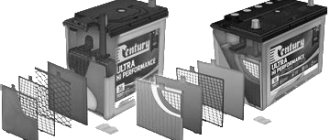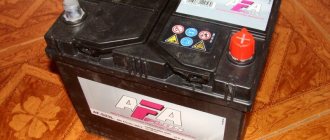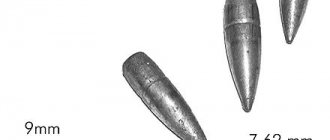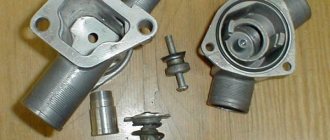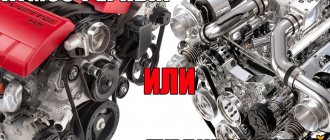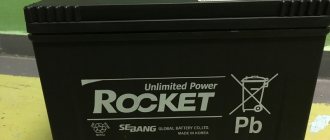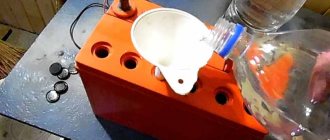Today's batteries require much less maintenance; there is no need to constantly check the electrolyte level or change it. These maintenance-free products are more durable, they are sealed and vibration resistant.
Over the past twenty years, car battery manufacturing technology has advanced significantly.
If previously it was necessary to regularly check the electrolyte level, today’s products require much less maintenance.
Manufacturers call the batteries maintenance-free and claim that they do not require monitoring of the electrolyte level. But such an assessment can lead to illusion among car enthusiasts. We will tell you what a “maintenance-free battery” means and its characteristics.
What is it and which is better?
The idea of a maintenance-free battery appeared with the entry into the market of automotive calcium batteries. In these products, the positive and negative electrode arrays are made of a lead-calcium alloy.
In the serviced batteries used previously, the lead plates had the addition of antimony. Antimony was added to strengthen the lead and at the same time it was a catalyst for the hydrolysis of water in the electrolyte. This reaction is essentially the decomposition of water into hydrogen and oxygen under the influence of an electric current. And it looks like evaporation. That is why the expression “boiling away” of water from the electrolyte appeared.
Manufacturers began to use calcium instead of antimony, and this decision turned out to be very successful. With the advent of such batteries, there was no need to add water.
Maintenance-free battery - what is it? - this is a sealed battery , without direct access to banks and plates, (most often calcium or hybrid).
Due to low self-discharge, all maintenance-free starter batteries are factory filled with electrolyte and sealed. The technology of such batteries requires long-term storage in a charged state.
In any case, you should sometimes check its voltage level; its value should be at least 12.5 volts. If the voltage is lower than indicated, the battery should be recharged. Manufacturers stipulate that this will have to be done no more than once every six months, and with hybrid grids the period between charges increases to one and a half years.
This is interesting: Is it possible to charge the battery without removing it from the car?
Of course, batteries should be stored in a cool, dry place with temperatures up to +16 degrees. Therefore, a battery that was manufactured 12 months ago and has undergone one charging cycle can also be successfully stored for a second year.
Selecting a device type
Currently, about 80% of all batteries on sale are of the maintenance-free type, and if we consider the question in the general case, which battery is better - serviced or maintenance-free, then for all categories of drivers it is recommended to choose the latter type, since its correct operation ensures a long service life services.
On average, a well-maintained battery lasts about 2-3 years without interruption if it is treated correctly. A maintenance-free option can successfully perform its functions for 5-7 years. Such batteries are guaranteed from 24 to 36 months, but if you choose a maintenance-free type of battery, you should opt for well-known companies.
If you purchase inexpensive batteries with a sealed case, then most likely they will fail in 2-3 years, since such models use thin lead plates that quickly begin to deteriorate.
Cheap devices usually come with a warranty of up to 1 year.
Battery design
Before choosing a serviceable or maintenance-free battery, you should decide on the type of its design. Based on this indicator, there are 3 options:
- Batteries consisting of lead plates and a sulfuric acid electrolyte. This is the most popular type of battery, which is common due to its low price. It is possible to recharge these devices, but deep discharge often leads to irreversible negative consequences for them.
- Gel batteries. In them, the working solution is an acid with silicon compounds dissolved in it to maintain the desired consistency. Such batteries are always produced in a sealed case, can operate at any angle of inclination and can easily withstand deep discharge. Disadvantages: relatively high price in relation to sulfuric acid devices, as well as strict requirements during the charging process.
- Another type of battery is AGM devices. They can be called hybrids between gel and standard batteries. Between their plates there is a filler, usually fiberglass, which is impregnated with a liquid working solution. Such electrical appliances operate at absolutely any angle of inclination, except for a vertical position upside down, and are resistant to any kind of vibration and mechanical stress. Their main drawback is that they require even more careful handling than gel batteries, since they can be damaged both during overcharging and during deep discharge.
If the driver has an old Zhiguli, then the best solution would be to purchase a standard acid battery. For a new car, it is preferable to take AGM batteries, which are capable of delivering a higher current at the start. As for gel batteries, they can be considered a luxury due to their high price. These reliable devices are also used to power powerful audio systems or to drive winches on vehicles equipped with them. In the latter case, in addition to the helium battery, another battery is used, which powers the electronic components of the car.
Other indicators
When choosing a battery, you should pay attention to other properties. One of them is the inrush current, which is indicated on the label of the device case. It is measured according to the following standards:
- EN: European standard indicating the maximum current in Amperes that a device can produce at a temperature of -18˚C for 10 seconds, while the voltage should not fall below 7.5 V.
- SAE: This is an American standard that determines the same current at the same temperature, but for 30 seconds. at a voltage not lower than 7.2 V.
- DIN: This is an industrial German standard according to which current is measured under the same conditions as in the SAE standard, only the voltage must not fall below 9 V.
It is the DIN standard that is preferable when choosing a powerful battery, since it undergoes more stringent testing compared to European and American standards. For example, 360 A according to the German standard corresponds to about 600 A according to EN. It is recommended to focus on this indicator if the battery is purchased for use in harsh winter conditions.
In addition to the starting current, an important characteristic is the battery capacity. It is always written on the battery case, and you should purchase a new device with a capacity not less than the specified one.
The most common models are those that have this characteristic between 55 and 70 Ah.
How to distinguish whether a battery is serviced or not?
A non-separable battery is a closed type battery; its case is sealed and the car owner will not be able to see its internal elements. If you turn it over, the electrolyte will not flow out of it.
In appearance , a maintenance-free battery can be identified by the following characteristics:
- Presence of viewing eyes on the surface and holes for gas outlet. To control charging, such models are usually equipped with a hydrometer and a peephole to check the electrolyte level.
- No traffic jams at the top. If there are any, and they can be unscrewed to see the condition and level of the electrolyte, and check its density, then this is a serviceable battery .
- Internal structure of the plates. In serviced batteries, where lead and antimony are used as grids, the electrolyte boils at 12.5 V, and because of this, the jars cannot be tightly closed to avoid their rupture. In hybrid ones, calcium-lead plates are used, which give a boiling reaction only at 14.5 V.
- Marking. The batteries are marked with designations that allow you to find out their main characteristics needed when purchasing: capacity, battery type, cold start current, and others.
Battery markings fall into two categories:
- Designations according to GOST.
- Marking according to DIN
According to GOST, the battery marking means, for example: 6ST-55A3
- 6-number of cans in the case.
- ST – purpose of the battery (Starter).
- 55 – capacity in Ampere-hours.
- A – general cover.
- H – filling with electrolyte.
It is allowed to indicate additional information in the attached passport for the battery.
According to the DIN standard, the designation consists of 3 groups of numbers:
- The first group contains the battery capacity.
- The second group of numbers contains technological features.
- The third group contains the starting current value.
The designation 574 012 068 is deciphered as follows:
5 – a number indicating the capacity value (5 – up to 100 Ampere-hour, 6 – from 100 to 200 Ampere-hour, 7 – over 200 Ampere-hour).
74 – capacity 74 Amp-hour.
012 – type of housing, size, installation type, pin placement.
This is interesting: Is it worth putting a car battery in a UPS?
068 – starting current 680 Amperes.
Manufacturers indicate in the battery labeling not the capacity, but the cold start current. The batteries also contain an additional code indicating the place and date of manufacture of the battery.
Maintenance-free batteries
Such batteries are presented in a sealed case without plugs or covers. That is, here on the body only the leads connecting to the battery terminals are visible.
But the principle of operation is similar to the previous option.
The main distinguishing feature is the sealed housing. When the electrolyte boils, water evaporates. But water vapor cannot leave the body, and therefore cools and settles. Liquid losses here are minimal. Only when there is excess pressure does the relief valve operate, in which case a small amount of water can escape from the housing.
As for the shortcomings, here we can highlight the following points:
- Inability to measure liquid density and level. These parameters can be controlled only by special marks on the body, or through the viewing eye. At the same time, it will not be possible to tell what exactly the density of the electrolyte is by immersing a hydrometer in it. The level indicator is also not entirely reliable.
- If one bank fails, it is impossible to find the exact problematic section. The same cannot be said about serviceable batteries.
- It is impossible to notice a change in the color of the liquid. And darkening or cloudiness of the electrolyte is a direct signal of problems with the battery.
To compensate for the capabilities inherent in serviced batteries, maintenance-free batteries are equipped with an overpressure relief valve, a level and density indicator.
If some of the electrolyte comes out through the valve, it will not be possible to fill in the missing amount of liquid without breaking the seal of the housing.
In fact, when the electrolyte level drops, the battery must be replaced.
Characteristics
A closed, sealed case is what distinguishes a serviceable battery from a maintenance-free one. The structure of such batteries is as follows:
- Negatively and positively charged lattice lead plates.
- Jars are separate containers with plates contained in them.
- Electrolyte.
- A housing with terminals, usually without plugs, but with inspection eyes.
The lattice structure is saturated with electrolyte and creates a chemical reaction. To separate the charged electrodes, a separator is installed inside the housing.
The battery case is made of durable material to ensure the integrity of the internal structure and is resistant to chemical influences.
One of the criteria when purchasing a battery is the duration of its use. The guaranteed operation of maintenance-free starting batteries is 5-6 years.
To use this product correctly, you must meet certain conditions:
- Charge the battery strictly according to the instructions. Maintenance-free batteries are sensitive to voltage fluctuations. When charging, it should not exceed 14.5 volts.
- Have the vehicle's on-board instruments working properly.
- Take into account temperature changes. In severe frosts, it is advisable to remove the battery, since if the charge is low, the electrolyte can freeze and cause the cans to swell.
- Consider the characteristics of your type of riding.
Important! When traveling around the city, the battery may not have time to recharge from the generator. Accordingly, in such cases you need to choose a battery with increased capacity.
Maintenance free batteries
In such batteries, the case is completely sealed and does not have technical holes for adding liquid. The operating principle and internal design remain the same, only the material used to make the plates changes.
Since the electrolyte may heat up and boil during battery operation, liquid vapors are not able to escape - they condense and turn back into liquid. Thus, the closed evaporation/condensation cycle guarantees a constant level of electrolyte and its characteristics.
But even here the designers could not avoid shortcomings.
If one or more plates are destroyed, the driver will never notice it. Similar processes are observed when the device is used incorrectly (frequent recharging, especially in winter, freezing of the electrolyte). If on serviced batteries the failure of one of the sections is not critical, here such problems quickly lead to failure of the entire device.
In addition, we note that serviced batteries are very sensitive to complete discharge - after 2-3 such situations they can be thrown away, so this must be monitored regularly.
However, the latest generation models have indicators of the level/density of the working fluid, as well as an emergency pressure release valve when the electrolyte boils, but this deprives maintenance-free batteries of their main advantage, since it leads to a decrease in the distillate level.
Serviceable battery
First of all, it is worth noting that the types of batteries under consideration differ significantly. Thus, the devices can have certain pros and cons that can greatly influence the decision to install a battery.
The main advantage of the serviced technology for experienced car owners is the complete control of the element. The design of the battery allows you to gain access to its “insides,” which can be useful in certain situations, for example, it becomes possible to check the level, density and condition of electrolytes. In addition, the user is able to independently inspect the lead plates, track the beginning of the sulfation process and the degree of charge of the battery by boiling.
Such openness of the element is of particular interest to experimenters, because with such a model it is quite easy to study the principle of operation of the battery, play with the density, liquid level and other parameters. However, for beginners, the need for constant monitoring can be difficult, and this is not the only drawback. People unfamiliar with battery design will encounter the following problems:
- Boil-off of the electrochemical composition. This battery model is not sealed, so it is difficult to avoid problems with its operation. As a result of a decrease in the level of electrolytes, the capacity of the cell decreases, i.e. its power is not enough to start the car engine.
- Increasing acid density. This factor leads to the destruction of lead plates and a reduction in the service life of the equipment.
- Accelerated sulfation process in open areas of the battery.
- Formation of plaque on the terminals, causing short circuits.
Despite the rather serious shortcomings, such an element can serve for a long time, but only with the direct participation of the owner. He will have to check all the battery parameters from time to time and, if necessary, raise them to normal levels. However, if the motorist is not ready to pay attention to this part of the car, then installing such a battery is stupid, since the period of trouble-free operation will be only 2-3 years.
